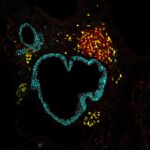
Publication: Characteristics of HIV-1 Nef regions containing multiple CD8+ T cell epitopes: wealth of HLA-binding motifs and sensitivity to proteasome degradation.
Publié dans: J Immunol 2001 May; 166(10): 6164-9
Auteurs: Choppin J, Cohen W, Bianco A, Briand JP, Connan F, Dalod M, Guillet JG
Résumé
First and foremost among the many factors that influence epitope presentation are the degradation of Ag, which results in peptide liberation, and the presence of HLA class I molecules able to present the peptides to T lymphocytes. To define the regions of HIV-1 Nef that can provide multiple T cell epitopes, we analyzed the Nef sequence and determined that there are 73 peptides containing 81 HLA-binding motifs. We tested the binding of these peptides to six common HLA molecules (HLA-A2, -A3, -A24, -B7, -B8, and -B35), and we showed that most of them were efficient binders (54% of motifs), especially peptides associating with HLA-A3, -B7/35, and -B8 molecules. Nef peptides most frequently recognized by T cells of HIV-1-infected individuals were 90-97, 135-143, 71-81, 77-85, 90-100, 73-82, and 128-137. The frequency of T cell recognition was not directly related to the strength of peptide-HLA binding. The generation of Nef epitopes is crucial; therefore, we investigated the digestion by the 20S proteasome of a large peptide, Nef(66-100). This fragment was efficiently cleaved, and NH(2)-terminally extended precursors of epitope 71-81 were recognized by T cells of an HIV-1-infected individual. These results suggest that a high frequency of T cell recognition may depend on proteasome cleavage.
Lien vers Pubmed [PMID] – 11342637

